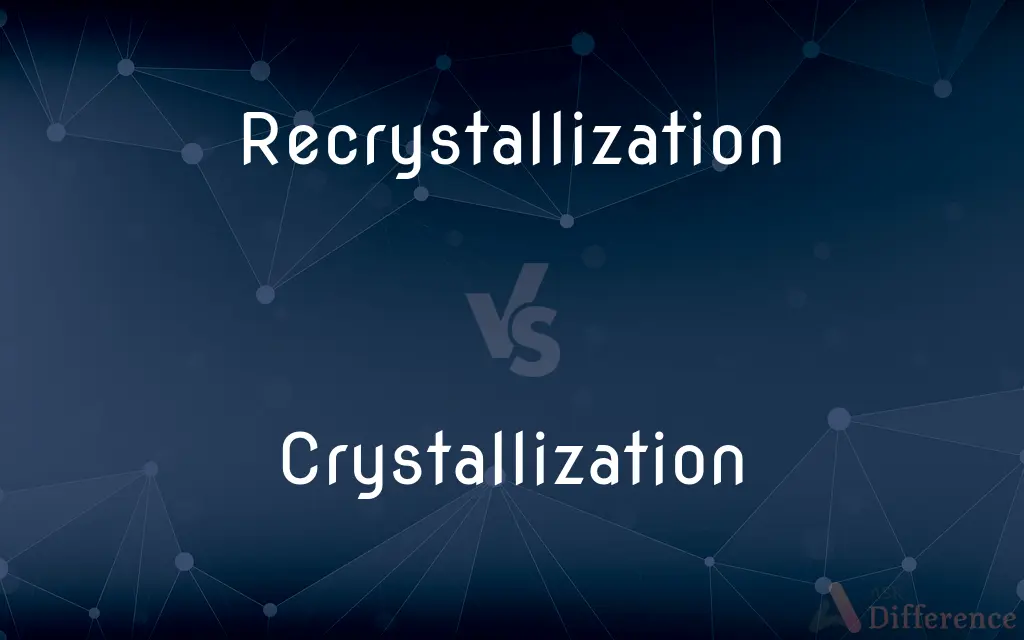Recrystallization vs. Crystallization — What's the Difference?
By Fiza Rafique & Urooj Arif — Updated on March 11, 2024
Recrystallization is a purification technique for solids, whereas crystallization is the process of formation of solid crystals from a homogeneous solution.

Difference Between Recrystallization and Crystallization
Table of Contents
ADVERTISEMENT
Key Differences
Recrystallization is a specific process used primarily for purifying solid compounds. It involves dissolving the compound in a solvent at a high temperature and then cooling the solution to precipitate the pure compound. This technique relies on the principle that the solubility of substances varies with temperature. The process is essential in chemical labs for obtaining pure substances from impure samples.
Crystallization, on the other hand, is a broader term that refers to the process of forming solid crystals from a liquid solution, melt, or more rarely, directly from a gas. Crystallization can be a natural process, as seen in the formation of snowflakes from water vapor, or a synthetic process used in various industries to obtain solid materials from their liquid phase. This process is fundamental in fields such as mineralogy, metallurgy, and pharmaceuticals, among others.
While recrystallization specifically aims at purifying a substance by exploiting the different solubilities at various temperatures, crystallization can occur under a wider range of conditions and serves multiple purposes, including the formation of new materials, separation of substances, and purification. Recrystallization is, in fact, a subset of crystallization processes, specifically tailored for purification.
The solvents used in recrystallization are chosen based on their ability to dissolve the impure substance at high temperatures and allow for the pure substance to precipitate upon cooling. In crystallization, the choice of conditions, including solvent (if used), temperature, and rate of cooling, depends on the desired properties of the final crystal, such as size, shape, and purity.
Techniques and equipment used in recrystallization and crystallization differ according to the scale and purpose of the process. For recrystallization, a common laboratory setup involves a heating apparatus to dissolve the substance in a solvent and a cooling method to precipitate the pure compound. In industrial crystallization, large-scale evaporators and crystallizers are used to manage the formation of crystals for various applications.
ADVERTISEMENT
Comparison Chart
Definition
Purification technique for solids, using solubility differences.
Formation of solid crystals from a homogeneous phase.
Purpose
To purify solid compounds.
To form solid materials, separate substances, or purify them.
Process
Involves dissolving the compound at high temperature and cooling.
Can occur from solutions, melts, or gases, under various conditions.
Solvent Use
Specific solvents chosen for their solubility properties.
Conditions and solvents (if used) depend on desired crystal properties.
Applications
Chemical laboratories for purifying substances.
Wide-ranging, including mineralogy, metallurgy, and pharmaceuticals.
Compare with Definitions
Recrystallization
Produces pure solid crystals from a solution.
Pure crystals formed as the solution cooled during recrystallization.
Crystallization
The process of forming solid crystals.
Crystallization of salt occurs as the water evaporates.
Recrystallization
Used in labs for obtaining pure substances.
Recrystallization is a common step in synthesizing pharmaceuticals.
Crystallization
Fundamental in mineralogy and metallurgy.
Crystallization techniques refine metals from their ores.
Recrystallization
Relies on solubility differences at various temperatures.
Recrystallization began with the compound completely dissolved at high temperature.
Crystallization
Influenced by temperature and cooling rate.
Slow cooling often results in larger, purer crystals.
Recrystallization
A method for purifying solid compounds.
The chemist used recrystallization to purify the crude sample.
Crystallization
Can happen from liquid, gas, or melt.
Snowflake formation is a natural crystallization process from water vapor.
Recrystallization
Involves careful choice of solvent.
Choosing the right solvent is crucial for successful recrystallization.
Crystallization
Used in various industries.
The pharmaceutical industry relies on crystallization for drug formulation.
Recrystallization
(chemistry) a technique for the purification of chemical compounds in which the compound is dissolved in a solvent and slowly cooled to form crystals
Crystallization
Crystallization or crystallisation is the process by which a solid forms, where the atoms or molecules are highly organized into a structure known as a crystal. Some of the ways by which crystals form are precipitating from a solution, freezing, or more rarely deposition directly from a gas.
Recrystallization
(geology) The process of existing grains in metamorphic rocks changing size.
Crystallization
To cause to form crystals or assume a crystalline structure.
Recrystallization
(metallurgy) the growth of grain fragments in an alloy, especially when it is worked by cold rolling
Crystallization
To give a definite, precise, and usually permanent form to
The scientists finally crystallized their ideas about the role of the protein.
Recrystallization
The process or recrystallizing.
Crystallization
To coat with crystals, as of sugar.
Crystallization
To assume a crystalline form.
Crystallization
To take on a definite, precise, and usually permanent form.
Crystallization
The act or process by which a substance in solidifying assumes the form and structure of a crystal, or becomes crystallized.
Crystallization
The body formed by crystallizing.
Silver on precipitation forms arborescent crystallizations.
Crystallization
The formation of a solid from a solution, melt, vapour or from a different solid phase
Crystallization
The process or the result of becoming more definite or precise.
Crystallization
The act or process by which a substance in solidifying assumes the form and structure of a crystal, or becomes crystallized; the formation of crystals.
Crystallization
The body formed by crystallizing; as, silver on precipitation forms arborescent crystallizations.
Crystallization
The formation of crystals
Crystallization
A rock formed by the solidification of a substance; has regularly repeating internal structure; external plane faces
Crystallization
A mental synthesis that becomes fixed or concrete by a process resembling crystal formation
Common Curiosities
What is crystallization?
Crystallization is the process through which solid crystals form from a homogeneous phase, such as a liquid solution, melt, or directly from a gas.
What factors influence crystallization?
Factors include the rate of cooling, temperature, presence of impurities, and solvent properties.
What is recrystallization?
Recrystallization is a technique used to purify solid compounds by dissolving them in a solvent at high temperatures and then cooling the solution to precipitate the pure compound.
Why is recrystallization important in chemistry?
It's crucial for obtaining pure samples of substances, which is essential for accurate chemical analysis and reactions.
Can recrystallization be used to purify any solid?
It can purify many solids, but the compound must be more soluble in the solvent at high temperatures than at low temperatures.
Is the solvent always removed after recrystallization?
Yes, typically the solvent is removed to isolate the pure solid compound.
How does the cooling rate affect crystal formation?
Slow cooling tends to produce larger, purer crystals, whereas fast cooling may lead to smaller, less pure crystals.
How is crystallization controlled in an industrial setting?
Through controlled temperatures, cooling rates, and the addition of seed crystals to encourage uniform crystal growth.
How do recrystallization and crystallization differ?
Recrystallization is a specific type of crystallization focused on purifying substances, while crystallization encompasses a broader range of processes for forming solid crystals.
What are some common applications of crystallization?
Applications range from the production of pharmaceuticals and food processing to mineral extraction and purification.
Can crystallization occur naturally?
Yes, crystallization can occur naturally, as seen in the formation of ice, snowflakes, and mineral deposits.
What is the key to successful recrystallization?
Choosing an appropriate solvent that dissolves the impure compound at high temperatures but not at low temperatures is key.
What role does crystallization play in water treatment?
It's used to remove impurities and minerals from water, improving quality and safety.
Why is the choice of solvent important in recrystallization?
The solvent must selectively dissolve the compound to be purified at high temperatures, allowing impurities to remain undissolved.
Share Your Discovery

Previous Comparison
Applicant vs. Candidate
Next Comparison
Carcinoma vs. AdenocarcinomaAuthor Spotlight
Written by
Fiza RafiqueFiza Rafique is a skilled content writer at AskDifference.com, where she meticulously refines and enhances written pieces. Drawing from her vast editorial expertise, Fiza ensures clarity, accuracy, and precision in every article. Passionate about language, she continually seeks to elevate the quality of content for readers worldwide.
Co-written by
Urooj ArifUrooj is a skilled content writer at Ask Difference, known for her exceptional ability to simplify complex topics into engaging and informative content. With a passion for research and a flair for clear, concise writing, she consistently delivers articles that resonate with our diverse audience.














































